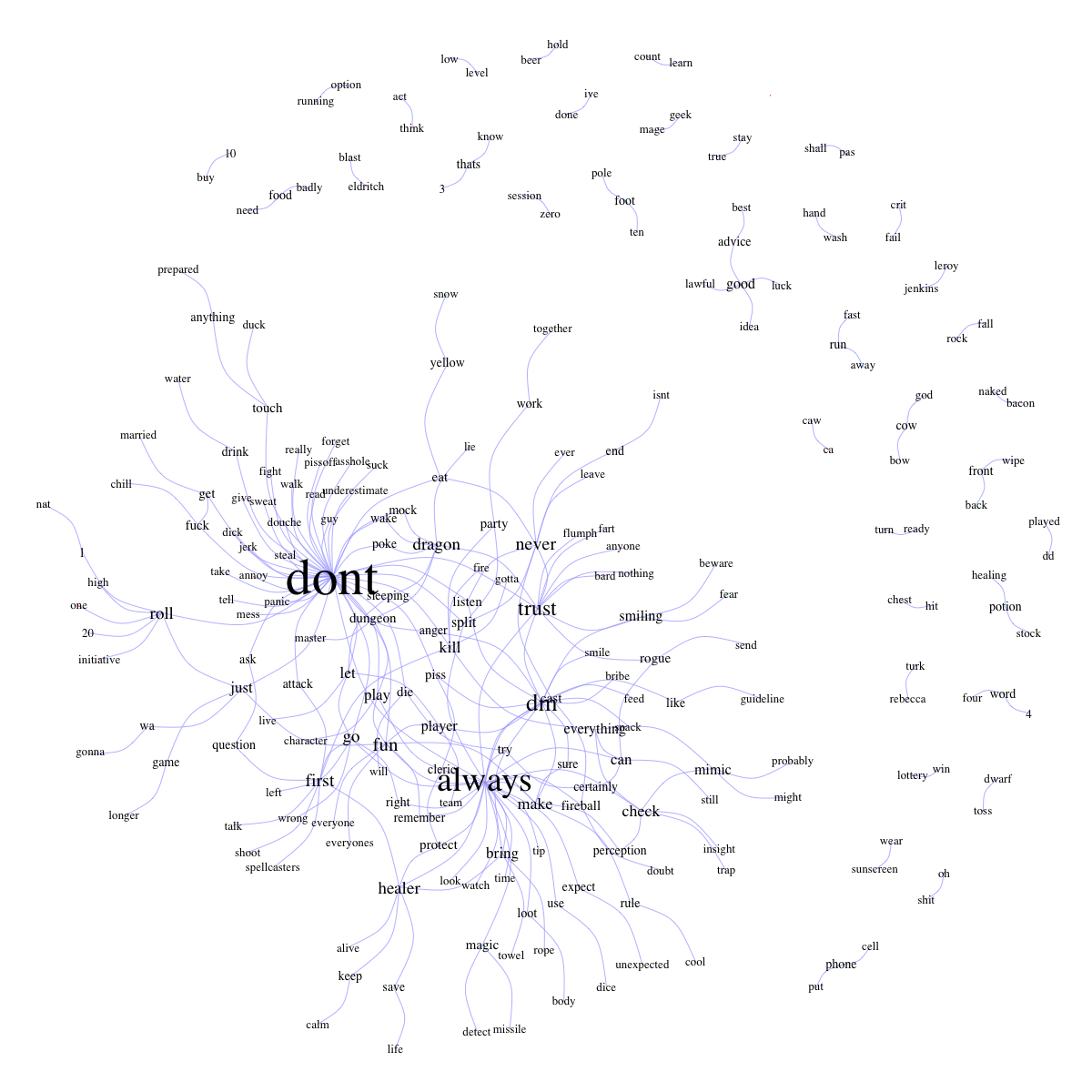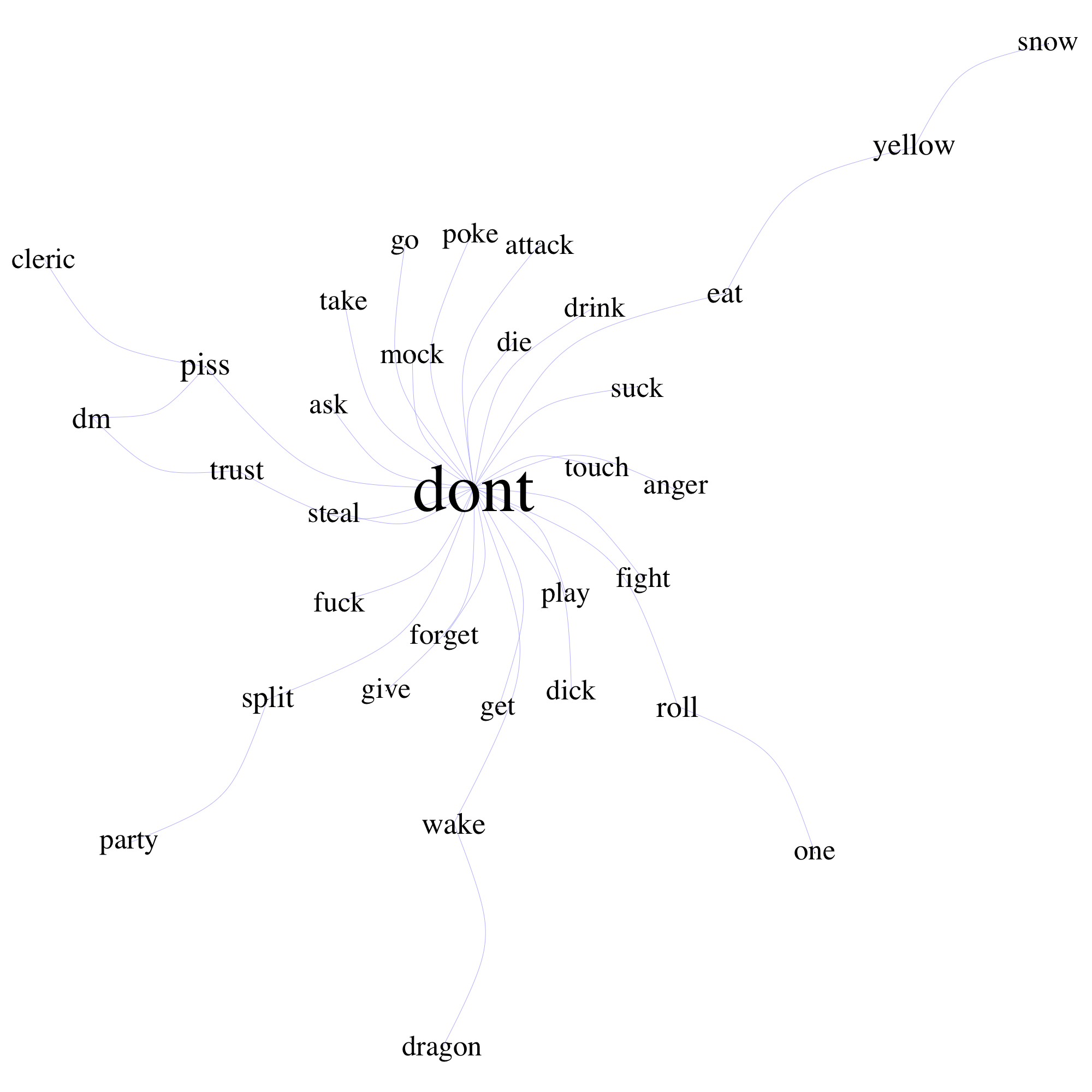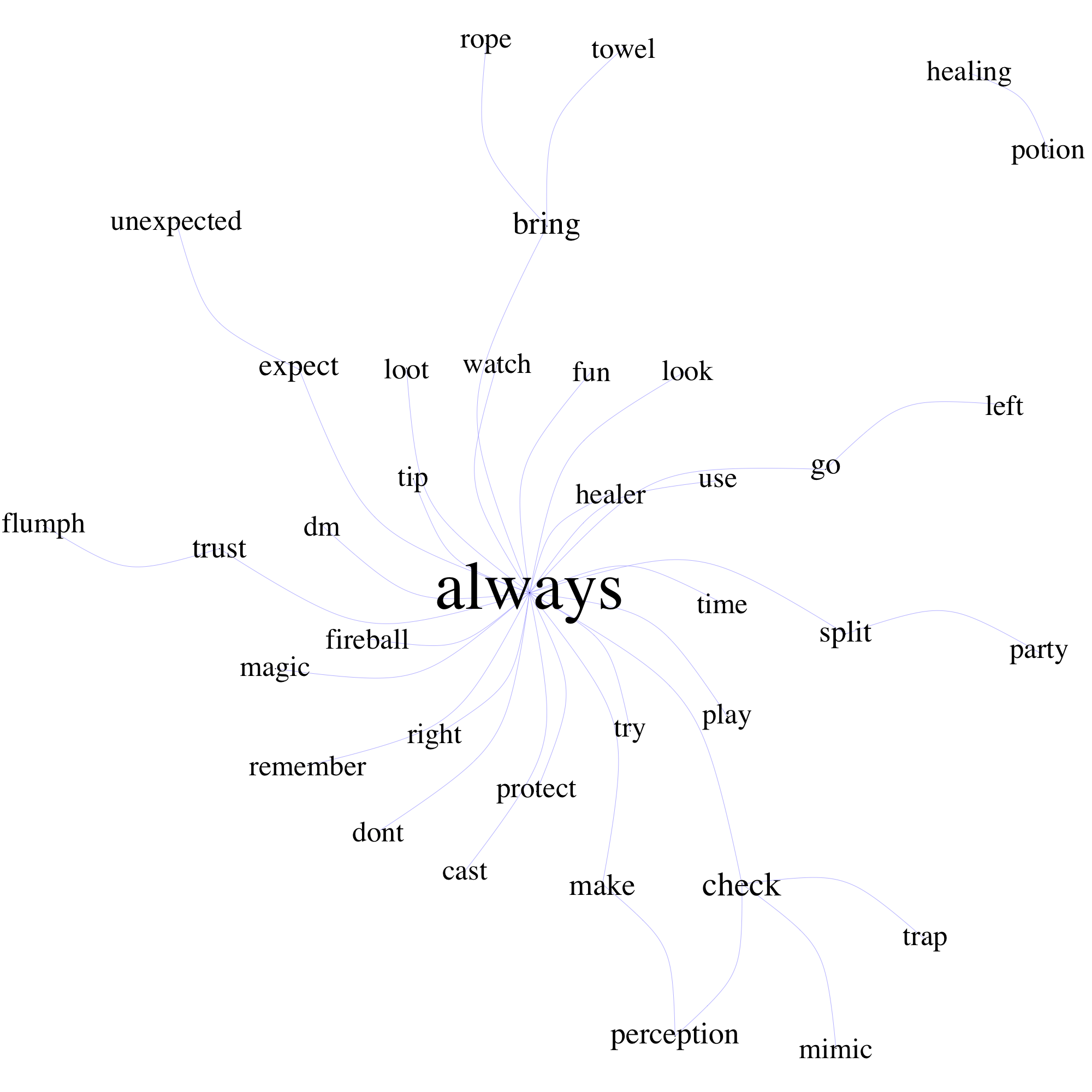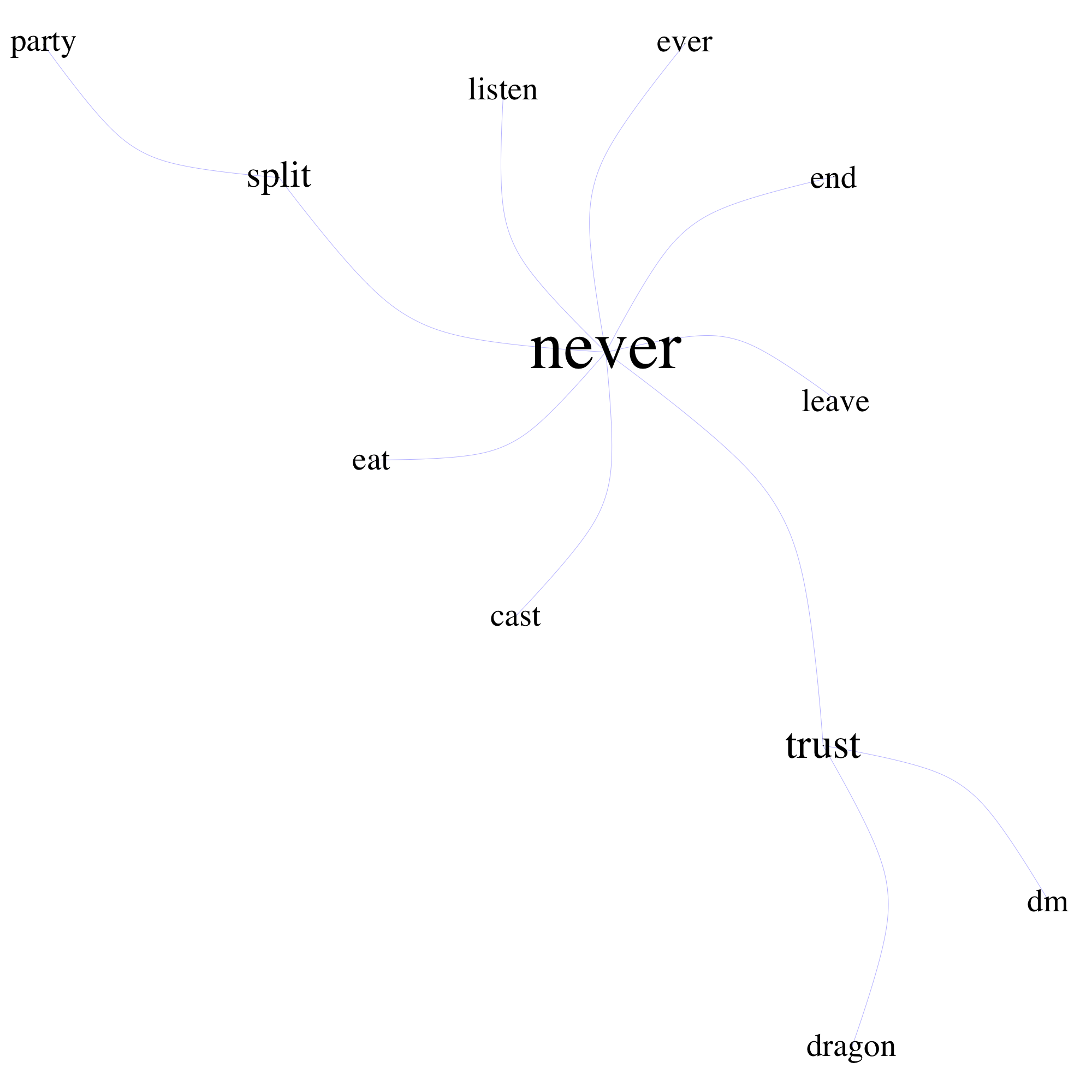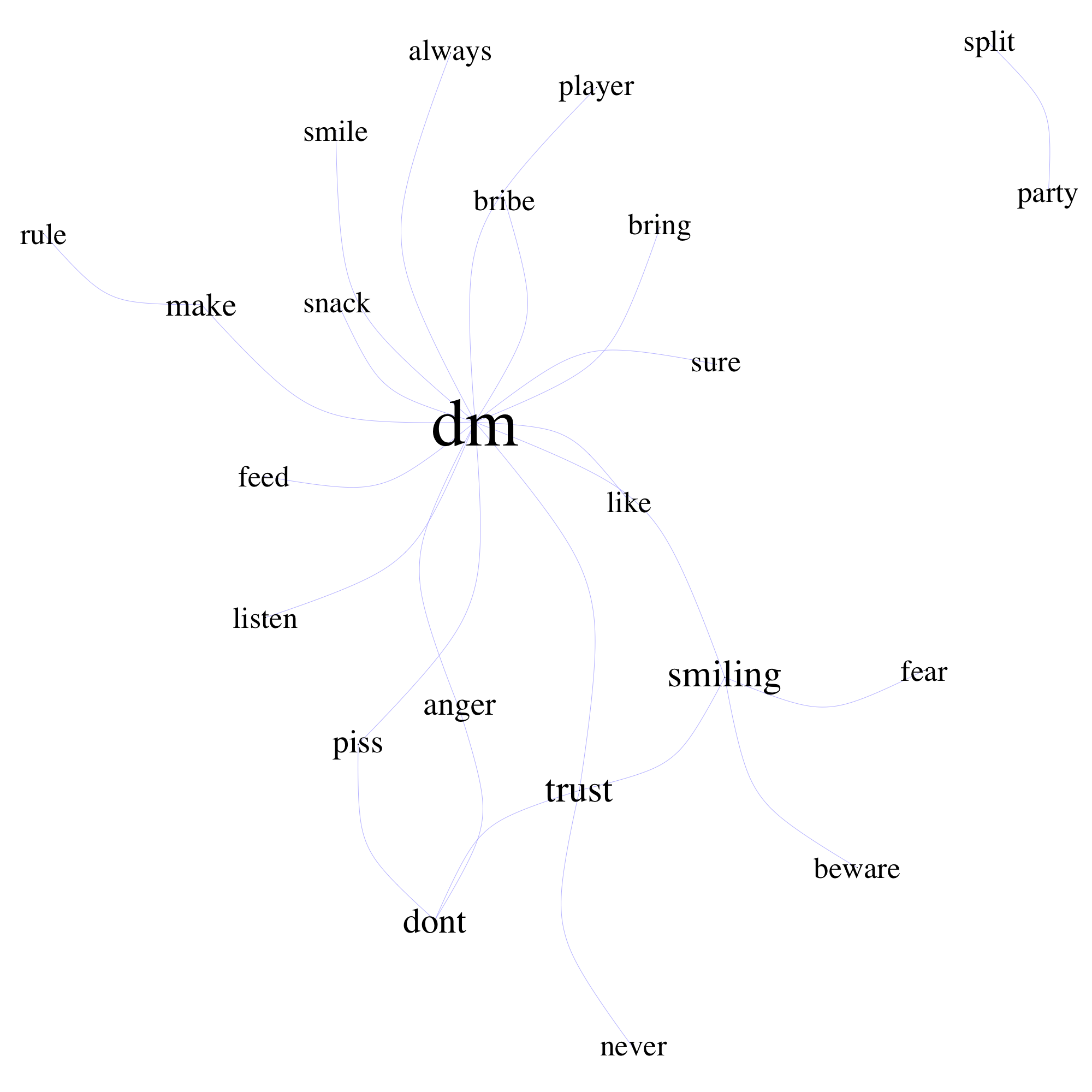New to Sly Flourish? Start Here or subscribe to the newsletter.
Analyzing the Best D&D Advice
by Mike on 22 May 2017
On 4 May 2017, Gill Sulivan posted a topic to the popular Dungeons & Dragons 5th Edition Facebook group asking for the best D&D advice in four words or less. This resulted in over 1,400 responses.
Rather than read all 1400 responses, we can process, extrapolate, and normalize them to identify common trends. Like our 2016 Dungeon Master Survey and our Analysis D&D Twitter Community, we can get quantitative information on the most popular advice D&D enthusiasts have to offer.
This article summarizes the results from the processed and analyzed text of the 1,400 responses to the request for the best D&D advice in four words or less.
Top Three or Four Word Statements
We'll start with the most useful look. Here's a list of common advice given three times or more along with the number of times these statements were given and their percentage of total responses.
- dont split the party (21, 1.4%)
- always check for traps (20, 1.4%)
- dont be a dick (11, 0.8%)
- dont eat yellow snow (11, 0.8%)
- trust the dm (7, 0.5%)
- its just a game (6, 0.4%)
- dont trust the dm (6, 0.4%)
- roll with it (5, 0.3%)
- always have fun (5, 0.3%)
- always go left (5, 0.3%)
- always have a healer (4, 0.3%)
- when in doubt fireball (4, 0.3%)
- remember to have fun (4, 0.3%)
- try not to die (3, 0.2%)
- dont roll a one (3, 0.2%)
- dont wake the dragon (3, 0.2%)
- be a team (3, 0.2%)
- beware the smiling dm (3, 0.2%)
- its only a game (3, 0.2%)
- kill it with fire (3, 0.2%)
- always trust a flumph (3, 0.2%)
- just roll with it (3, 0.2%)
- dont trust the rogue (3, 0.2%)
- check for mimics (3, 0.2%)
- protect the cleric (3, 0.2%)
- just have fun (3, 0.2%)
- expect the unexpected (3, 0.2%)
- its probably a mimic (3, 0.2%)
We get this list by normalizing words, looking for three- and four-word phrases (called ngrams) without removing common words (called stopwords), and normalizing the word "never" (used 79 times) to "dont" (used 252 times). We also cleaned it up into sentences that made sense. That's probably the best list of responses we're going to get.
We can dig a bit deeper, though, by looking at top words, bigrams, and trigrams.
Top Words
The following is a list of the top 100 words given in the 1,453 responses:
dont (252, 17.3%), always (152, 10.5%), never (79, 5.4%), dm (79, 5.4%), fun (58, 4.0%), check (47, 3.2%), trust (45, 3.1%), first (40, 2.8%), party (36, 2.5%), just (35, 2.4%), kill (35, 2.4%), go (35, 2.4%), trap (34, 2.3%), dragon (32, 2.2%), roll (31, 2.1%), get (28, 1.9%), eat (27, 1.9%), game (26, 1.8%), play (26, 1.8%), make (25, 1.7%), split (25, 1.7%), die (24, 1.7%), player (24, 1.7%), cleric (24, 1.7%), bring (22, 1.5%), let (22, 1.5%), healer (20, 1.4%), advice (19, 1.3%), good (19, 1.3%), mimic (19, 1.3%), try (19, 1.3%), rogue (19, 1.3%), fireball (18, 1.2%), run (18, 1.2%), thats (18, 1.2%), fuck (18, 1.2%), everything (17, 1.2%), dice (16, 1.1%), keep (16, 1.1%), one (16, 1.1%), word (15, 1.0%), take (14, 1.0%), doubt (14, 1.0%), dick (14, 1.0%), rule (13, 0.9%), cast (13, 0.9%), listen (13, 0.9%), look (13, 0.9%), touch (13, 0.9%), loot (12, 0.8%)
Not entirely useful although we can see some interesting trends.
Word Graphs
By connecting every pair of words, once common words are removed, we can build a graph of the connections of words. The following image represents a graph of word connections for every word pair that appeared two or more times. This results in a graph of 241 words and 251 word-connections. Click on it to get a high resolution version.
Specific Word Graphs
We can take this graph and break it down into those that contain the top four words found across all 1,400 resposes. Here are the word graphs for "dont", "always", "never" and "dm". These graphs are limited to two or more connections between words.
What can we Learn From This?
What does all of this tell us? First, it's interesting that 23% of tips told us NOT to do something (don't / never). Is being a good DM or player more a matter of what we don't do instead of what we do do?
There's also a lot of folks who didn't take this too seriously, so neither should we. How much yellow snow do we actually come across in our D&D games? Always checking for traps and never splitting the party is sound advice and not a surprise (cheers to the the central limit theorem!). Not eating things in general is also good advice. Never trusting the DM is interesting and probably fair. A good DM telegraphs this trust, though. Sometimes we should trust the DM, sometimes not.
Even if this is a bit of a silly exercise, its always interesting to see how people reply to questions like this.
How I Did This Analysis
For this analysis, I copied and cleaned up the list of 1,453 total responses in the Facebook thread. I cleaned it up with a mixture of Sublime regular expressions and Python using Python Anaconda and Jupyter which comes in Anaconda. The text processing was all done with Python Anaconda, the NLTK library, and Jupyter. The word graphs were built using R Studio and the iGraph library.
Related Articles
- 2016 Dungeons & Dragons Dungeon Master Survey Results
- The Top Traits of a Good Dungeon Master
- Substitution Cipher Puzzles
Subscribe to the Newsletter
Subscribe to the weekly Sly Flourish newsletter and receive a free adventure generator PDF!
